There are several types of heating systems used in homes and buildings, each with its own advantages, efficiency levels, and costs. Here’s an overview of the most common types:
1. Furnaces (Forced Air Heating)
- How it works: Burns fuel (natural gas, oil, or electricity) to heat air, which is distributed through ducts by a blower.
- Common Fuel Sources: Natural gas, propane, electricity, or oil.
- Pros: Quick heating, compatible with air conditioning, effective for whole-house heating.
- Cons: Can be noisy, requires ductwork, potential heat loss through ducts.
2. Boilers (Hydronic Heating)
- How it works: Heats water or steam that circulates through radiators, baseboards, or radiant floor systems.
- Common Fuel Sources: Natural gas, oil, or electricity.
- Pros: Consistent heat, quieter than forced air systems, no ductwork needed.
- Cons: Slower to heat up, can be expensive to install, higher maintenance for older systems.
3. Heat Pumps
- How it works: Moves heat from outside to inside (and vice versa for cooling), rather than generating heat.
- Types:
- Air-source heat pumps (extract heat from outdoor air).
- Ground-source/Geothermal heat pumps (extract heat from the ground).
- Pros: Energy-efficient, provides both heating and cooling, lower running costs.
- Cons: Can be less efficient in extremely cold climates (unless using a cold-climate model), higher upfront costs.
4. Radiant Heating (Radiant Floor or Panel Heating)
- How it works: Provides heat directly to floors, walls, or ceilings via electric heating elements or water-heated tubing.
- Types: Hydronic (water-based) or electric radiant floors.
- Pros: Comfortable, silent, more even heat distribution.
- Cons: High installation costs, slow to heat, difficult to retrofit into existing homes.
5. Electric Resistance Heating
- How it works: Converts electricity directly into heat via baseboard heaters, space heaters, or electric radiant floors.
- Pros: Easy installation, zoned heating options, no fuel storage needed.
- Cons: Expensive to operate, less energy-efficient compared to other systems.
6. Solar Heating Systems
- How it works: Uses solar collectors to capture and convert sunlight into heat, which is stored and distributed.
- Types: Active systems (use pumps and controls) or passive systems (rely on the design of the building).
- Pros: Renewable energy source, reduces energy bills.
- Cons: High upfront costs, requires adequate sunlight and space for collectors, usually a supplement to other heating systems.
7. Wood-Burning and Pellet Stoves
- How it works: Burns wood or wood pellets to generate heat, either through standalone stoves or fireplace inserts.
- Pros: Cost-effective fuel, creates a cozy atmosphere, good for small spaces.
- Cons: Requires manual fueling, ash cleanup, less consistent heat, can be inefficient for whole-house heating.
8. Steam Radiators
- How it works: Uses steam generated by a boiler, which is sent through pipes to radiators, where it condenses and releases heat.
- Pros: Effective heating, durable systems.
- Cons: Can be bulky, slow to adjust temperature, potentially noisy.
9. Hybrid Heating Systems
- How it works: Combines a heat pump with a furnace (usually gas) to optimize heating based on outdoor temperatures.
- Pros: Energy-efficient, can switch between heat sources for best performance.
- Cons: Higher initial cost, complex system to install and maintain.
Each of these heating systems comes with its own considerations regarding installation, running costs, and efficiency, so choosing the right one depends on factors like climate, energy costs, and home size.



Recent Comments